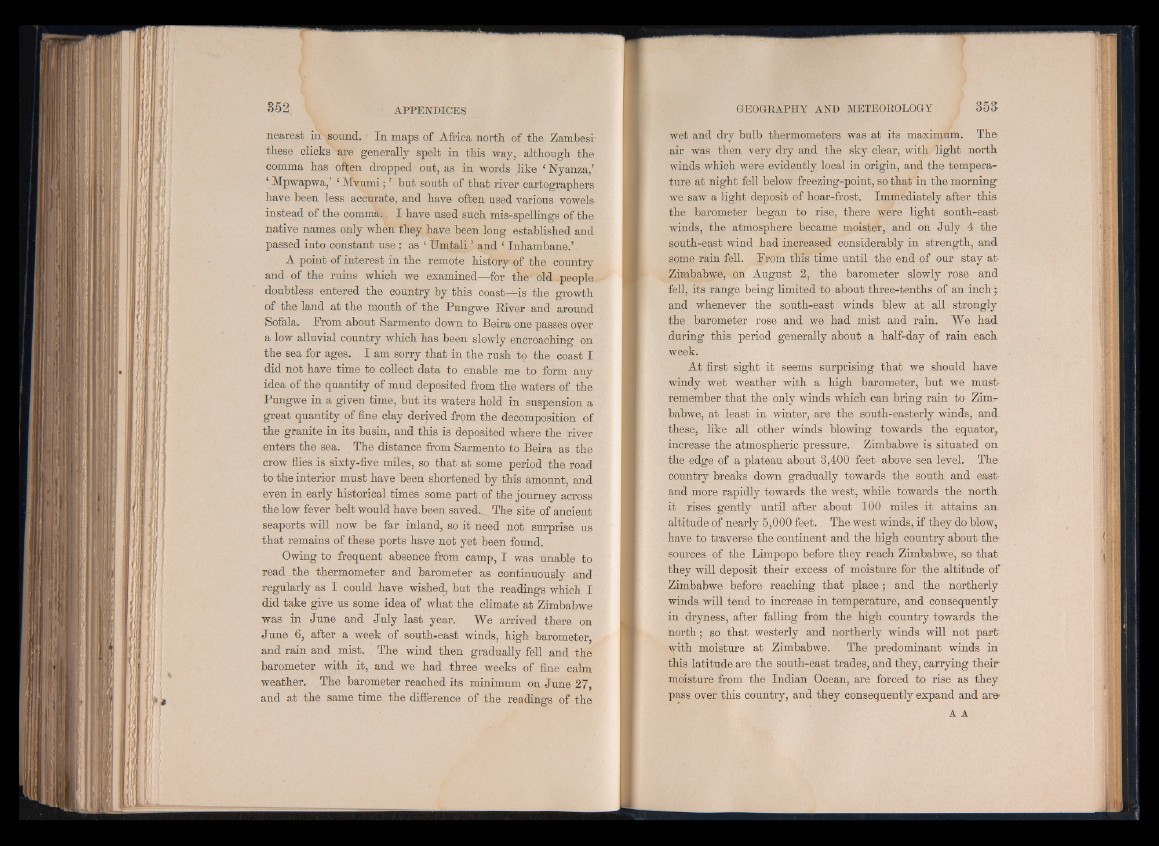
nearest in sound. * In maps of Africa north of the Zambesi'
these clicks' are generally spelt in this way, although the.
comma has often dropped out, as in words like ‘ Nyanza,’
‘ Mpwapwa,’ * Mvumi; } but south of that river cartographers
have been less accurate, and have often used various vowels
instead of the comma.. I have used such mis-spellings of the
native names only when they have been long established and
passed into constant- u s e : as ‘ Umtali ’ and £ Inhambane.’
A point of interest in the remote history of the country
and of the ruins which we examined—for the- old people
doubtless entered the country by this coast—is the growth
of the land at the mouth of the Pungwe River and around
Sofala. Prom about Sarmento down to Beira one passes over
a low alluvial country which has been slowly encroaching on
the sea for ages. I am sorry that in the rush to the coast I
did not have time to collect data to enable me to form any
idea of the quantity of mud deposited from the waters of the
Pungwe in a given time, but its waters hold in suspension a
great quantity of fine clay derived from the decomposition of
the granite in its basin, and this is deposited where the river
enters the sea. The distance from Sarmento to Beira as the
crow flies is sixty-five miles, so that at some period the road
to the interior must have been shortened by this amount, and
even in early historical times some part of the journey across
the low fever belt would have been saved. The site of ancient
seaports will now be far inland, so it need not surprise us
that remains of these ports have not yet been found.
Owing to frequent absence from camp, I was unable to
read the thermometer and barometer as continuously and
regularly as I could have wished, but the readings which I
did take give us some idea of what the climate at Zimbabwe
was in June and July last year. We arrived there on
June 6, after a week of south-east winds, high barometer,
and rain and mist. The wind then gradually fell and the
barometer with it, and we had three weeks of fine calm
weather. The barometer reached its minimum on June 27,
and at the same time the difference of the readings of the
wet and dry bulb thermometers was at its maximum. The-
air was then very dry and the sky clear, with light north
winds which were evidently local in origin, and the temperature
at night fell below freezing-point, so that in the morning'
we saw a light deposit of hoar-frost. Immediately after this
the barometer began to rise, there were light south-east
winds, the atmosphere became moister, and on July 4 the
south-east wind had increased considerably in strength, and
some rain fell. From this time until the end of our stay at
Zimbabwe, on August 2, the barometer slowly rose and
fell, its range being limited to about three-tenths of an inch
and whenever the south-east winds blew at all strongly
the barometer rose and we had mist and rain. We had
during this period generally about a half-day of rain each
week.
At first sight it seems surprising that we should have
windy wet weather with a high barometer, but we must-
remember that the only winds which can bring rain to Zimbabwe,
at least in winter, are the south-easterly winds, and.
these, like all other winds blowing towards the equator,
increase the atmospheric pressure. Zimbabwe is situated on.
the edge of a plateau about 3,400 feet above sea level. The
country breaks down gradually towards the south and east
and more rapidly towards the west, while towards the north
it rises gently until after about 100 miles it attains an
altitude of nearly 5,000 feet. The west winds, if they do blow,
have to traverse the continent and the high country about the-
sources of the Limpopo before they reach Zimbabwe, so that
they will deposit their excess of moisture for the altitude o f
Zimbabwe before reaching that place; and the northerly
winds will tend to increase in temperature, and consequently
in dryness, after falling from the high country towards the-
north; so that westerly and northerly winds will not part
with moisture at Zimbabwe. The predominant winds in
this latitude are the south-east trades, and they, carrying their
moisture from the Indian Ocean, are forced to rise as they
pass over this country, and they consequently expand and are
A A